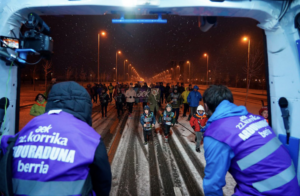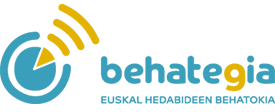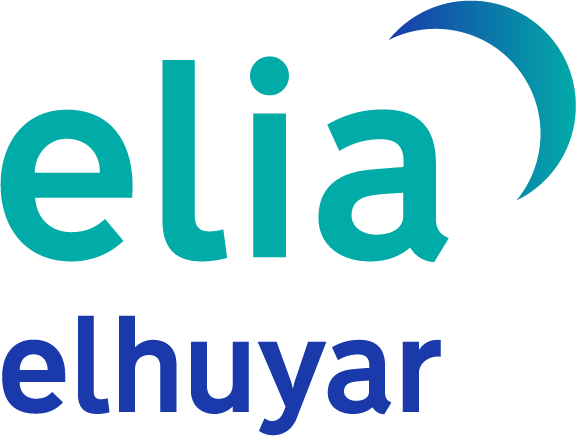We are pleased with the results of the collaboration between EITB, Tokikom and Goiena. There are not many examples yet, but there is a basis for starting to build them from there.
EITB is open to partnerships and local media. This makes it possible to invent and test new ways of doing so.
The decision has been to act without losing time in reflections, learning with action and believing that friction has benefits. The goal, always making better content and believing in what we do. By joining forces, the aim of the effort is to develop and exchange the Basque communication framework to develop a model of collaboration between local and national media.
This article analyzes two concrete examples: one, the television program jointly developed by ETB 1 and Goiena, on the eve of San Juan in Arrasate-Mondragón; and the other, the collaboration based on data journalism, called Saretzen. Both are interesting and we want to repeat them in the future.
Cooperation stemming from real cooperation
It is not new the business of these companies, nor the road worked together. Moving to action responds to a desire: better responding to the needs of practice in a minority language:
- Radio programme since 9 September 2013 (9 years): Tokikom"s media have space in the messenger. -Each week the valley to valley radio program is held. In Euskadi Irratia, the leading radio in the entire Basque Country, a local story is made: stories, news, interviews…
- Exchange of images in daily news items (22 years): the relationship between those responsible for the production of information is remote. In daily news reports, demand for images is common on both sides. There are many images exchanged in both EITB and Goiena.
- We shared technological advances (6 years): An application developed by EITB was replicated to make a small à la carte. All the generated code was used, the company was asked to develop an application for local TV. There were no problems and the application was developed and visualized from the Hiru application.
After the action, the agreement:
The first agreement was signed under the direction of Maite Iturbe on 15 May 2014. The document stated the intention of companies to ‘develop and consolidate the Basque Communication Area by establishing the most appropriate initiatives and formulas when publishing the information needs of the population’. The action was more important than the small letter of the convention. We agreed on a rather large umbrella to act with some flexibility. Before the convention, on a daily basis, the links worked. Also between Arrasate Telebista and Euskal Telebista for a longer time. Subsequently, for example, local television stations in Tokikom have received several ETB programmes at a symbolic price. Especially cartoons and fiction.
Another agreement was signed in November 2021, but previously the exchange of information between the two companies continued. EITB’s decision to facilitate access to various reports and documents has been expressed as part of the collaboration between Tokikom and EITB in the Mirrors (information on communication groups similar to EITB), Sound (global trends in the field of audio, in the widest sense: radio, podcasts, music, creativity…) and despite being public (NOR Ikerta research) Results of the panel of 2,400 young people aged 14 to 24 from Araba, Bizkaia, Gipuzkoa and Navarra of the Applika initiative (carried out between the UPV/EHU, EITB, the Cultural Observatory and the Tabakalera 2deo laboratory).
In the latter case, the streaming platform Tik Tok, the streaming platform Twitch, Youtube, podcasts, or Goiena has decided to rely on the results obtained from questionnaires such as information and Ukraine, such as Hi gazte! also use Tik Tok in a project aimed at youth audiovisual creation. There is a task:
“Among the languages seen in Tik Toke are Spanish and English. 72.1% said that the videos they see predominate in Spanish and 25.8% in English. Basque and other languages are mentioned by 1%’.

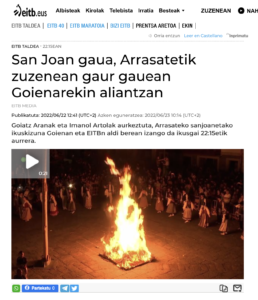
Hi, gazte! It is a project of the Provincial Council of Gipuzkoa managed by Goiena after winning a public competition. In 2022, the dynamic has developed for the second consecutive year, with over 1,000 young people participating each year. Fourteen schools from all districts and networks in Gipuzkoa participated: IES Orixe, Uzturpe, Jakintza, IES Elgoibar, La Salle Azitaingo Ama, IES Eibar, Egiluze Hondarribia, Herri Ametsa, La Salle Berrozpe, Iraurgi, Ikasberri, IES Azkoitia, Aranzadi and Oñati. A lot of videos have been uploaded getting 14.6 K likes. It was the second time of the project and in the networks has achieved a strong involvement of the young Hi, gazte! profile: 865 Instagram followers and 1,801 Tik Tok followers. To get this data, no followers have been purchased, although this is common. It didn"t make sense to cheat ourselves, because the new experimentation was attractive and even for the media to come to conclusions. It has to be said that the Representative frames this action within Etorkizuna Eraikiz and that in this second stage the UPV/EHU will carry out a study on this action, namely the NOR Research Group. Research will lead to results from which audiovisual media professionals should learn.
Other studies EITB makes available to the premises, including Digital News Report, a study by the Reuters Institute.
Obviously, the premises would have difficulty following the path of what moves, as these studies are expensive and require the applicant to be on the tests. EITB has felt and wanted these studies paid with public money to be made available to the signatory institutions. Technological surveillance and new media tests are possible.
We said that the action was first and then the agreement. Meetings on the renewal of the Convention for the drafting of this Article have been held. The document was signed on 28 November by EITB and Tokikom. It allows us to work together on data journalism and manage and exploit it together. The project aims to work data journalism together and collaboratively, following the BBC Local News Partnership model and dozens of local media in the UK.

The first result was published in the media of EITB and Tokikomen, where significant data were collected from the thousands of viewers and readers who consume the signatory media. It focused on Basque demography, adapted to its scope, characteristics and scope.
Specifically, demographic data of the Southern Basque Country between 2001 and 2021 were worked from sources such as Eustat and Nastat. In addition to analyzing the evolution of the population in the last 20 years, an X-ray of the society was performed in terms of population, aged society and birth rate. It focused on the phenomena that occurred by region and also the municipalities were analyzed, analyzing data from regional, urban and local realities. This will be the main feature of the Saretz project, which, once the data has been collected together, has its specific treatment adapted to the scope of each media.
It should be noted that data collection is massive, to which it should be added that the one shared between the media is not the only reading of the data. It"s not about all media coming out with the same results, it"s about how each media knows how to publish the data and stories that are most interested in their client.
Two working teams working as one
It is one thing to exchange content and/or capture information given by a means of communication and adapt it to the way of doing its own, and another thing is to put two teams, two companies, two cultural companies around the table and agree sessions. That"s what"s been done during the 2022 holidays: putting two teams to work as one.
The result has been satisfactory. It has served to unite the knowledge and technique of the festival in the region, in this case in Arrasate-Mondragón. The experience, material and dissemination of EITB in the elaboration of audiovisual content is what Goiena knows. Professional technicians from both companies have joined together and developed a programme model.
- The key has been the willingness to cooperate, based on respect between the work teams, and working together, the result has been satisfactory. Obviously, with a better result, the viewer is the one who receives the best product in his home, on his mobile phone…
- Feeling that the two sides are winning. The local media knows the local (event, protagonists…) and ETB has better means to record a live event (mental heat, lighting…). The other wins what each one puts.
- What everyone knows has not been hidden. The add-ons for a good session have been put on the table and managed as efficiently as possible.
- Equipment optimization. It is a mass event on the eve of San Juan in Arrasate. With this in mind, to minimize the discomfort to attendees, instead of duplicating the equipment to be assembled, they were optimized.
- The broadcast was broadcast on two television channels. This means the sum of viewers and the need to count audiences differently.
There are also things to improve, no doubt:
- Brand. It must be made more obvious that both companies work together. It was not concealed, and was highlighted several times by the presenters of Goiena and EITB, but it would help the differentiated elaboration of the imaginary.
- Each media works in different ways. It is advisable to disseminate the discourse of collaboration among workers, especially those who collaborate. It has to be passed down from the top to the bottom so that we all act in the same direction and collaboration becomes more natural when transmission occurs. It is a beginning and it seems that it can be a way of doing other sessions.
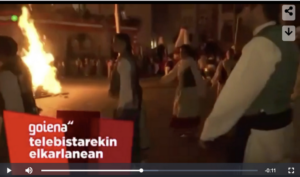
In the near future:
We learned from the BBC during our stay in Seu d’Urgell (Catalonia). The CIMP meetings were held and invited by the Catalans. Heard at the conference of Matthew Barraclough (BBC Local News Partnerships: A collaboration supporting local public interest news in the UK ) was very interesting and inspiring to bring Euskal Herria. They demonstrated a three-pillar alliance with local journals: LDRS, Local Democracy Reporting Service, Sharet Data Unit and BBC News hub. What more interesting.
The media are needed to promote democracy. They created a partnership to maintain local democracy and improve journalistic standards. It is not a question of replacing, but of helping to improve what those present and those who are do. There are 1,100 local media outlets within the scope of the BBC, with which the BBC started a new relationship. They thought about the homogenizing standard and agreed on the principles of being fair and non-discriminatory. At first, 800 media outlets came together and benefited from data journalism, sharing videos, etc.
We ourselves have needed the following steps to reach what we do together today:
- A couple of people from Tokikom shared knowledge with this half-dozen BBC team, and so we got to know Local Democracy Reporting Service better.
- They were then invited to the Tokikom days on 12 November 2021.
- The EITB leaders and managers, as well as the BBC participants, told us how they work with local media in the UK, we make a full day stay at EITB headquarters. We also worked on how this collaboration could be translated.
- The BBC gave us access to the course it gives the locals and we learned the daily dynamic as if we were one more. They told us that it was part of their vocation as a public service, but it is to be welcomed their will with us.
- EITB and Tokikom agreed that data journalism would be the subject of collaborative work and that both entrepreneurs were well served.
- From what we learned there we started the first pilot.
Description of the results obtained
San Juan (Goiena -ETB 1)
Goiena telebista offered special programming on St. John"s Eve 2022. At 18:00, the Hemen Debagoiena session was offered live from the Herriko Plaza, including the poplar climb. Later, at 22:15 hours, in collaboration with ETB, a special dedicated to the night of San Juan was issued, presented by Goiatz Arana – Goiena presenter – and Imanol Artola – ETB presenter.
It was the result of the collaboration between the two communication groups, at the same time the live broadcast on TV Goiena and ETB 1.
Clearly, the assessment of the sanjuanes" work is good. Previously, ETB and local TVs have collaborated in the live performances of the Korrika, and the sum of efforts has always been enriching, although, as already mentioned, some aspects can be improved. The goal of appearing nearby has been met. The joint work between the teams of Tokikom and EITB is enriching and the viewer feels the emotion of what is told, more local, and incorporates the personality of the initiative. The aim of EITB is to disseminate relevant developments in this country. And in order to share all these special emotions of the place, you need to follow the path that you"ve taken with Tokikom.
Goiena magazine collected the statements of the directors of the two media:
Unai Iparragirre, ETB Director:
‘ETB and Goiena will collaborate on the eve of San Juan from Arrasate. Cooperation greatly enriches the content, and the public also comes out. We owe this to the Basque Country’
Iban Arantzabal Arrieta, director of Goiena:
“Goiena has for years signed a partnership agreement with EITB since she was director of Maite Iturbe. Andoni Aldekoa has also stated in his strategic plan the need for alliances. We are now in the time to put content on words, and this joint issue is an example of that. A good start that we would like to see continued. Oihane Agirre and Unai Iparragirre have facilitated this pass. On the eve of San Juan de Arrasate-Mondragon will be seen by more people than ever»
Data journalism (Tokikom-EITB)
EITB and the local media network Tokikom published the results of Saretzen on 29 November, in order to work together on data journalism and manage and exploit them together. The aim of the project is also to work data journalism together and collaboratively, following the BBC Local News Partnership model and dozens of local media in the UK.
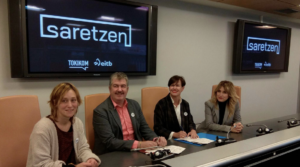
This first result was published in the EITB and Tokikom media. The demography of Hego Euskal Herria was analyzed and this particular topic was addressed both by the EITB and Tokikom media, adapting to its scope, characteristics and scope. Prior to the publication of the results, the team of two or three journalists from Tokicome and EITB carried out important documentation to organize all data and figures and to produce a report that was of great interest to all.
Seventeen local media analyzed the demographic data of Hego Euskal Herria between 2001 and 2021. There were those who did the monograph; for example, Goienaren Puntoa magazine took 48 pages and worked on the subject in depth. This will be precisely the main feature of the Saretz project, which, once the data have been collected in a unified way, its specific treatment is in line with the scope of each media.
In the medium future
Future agreements between EITB and the Tokikom network
takes up the shared challenge of reflecting on the audiovisual model and has already opened up new avenues.
- Leisure: generation of program alternatives taking advantage of local knowledge.
- Information: see if a stable data table is possible, the permanent unit of EITB – Tokikom, related to data journalism (currently under study).
Working on the development of the convention
The agreement is signed and is open to further content. Both local companies and EITB have the will and mutual knowledge does not cease. The Alliance has a future and the agreement will facilitate partnerships that the public will not see first person. They will also be more visible, as is the case of Saretzen and San Juan. More elaboration and more sessions will come.
The Primeran platform stands out. It also has a place in the development of the convention and Tokikom will assume the EITB proposal. This year, driven by EITB, the digital window of Basque and Basque audiovisual content will be born in Primera. All studies indicate that digital windows take more and more minutes and that audiovisual consumption is on the platforms. It will be a container of all kinds of Basque themes: information, sport, special performances, parties, films, documentaries, culinary contents, adventure… All audiovisual content that identifies us as a people. It is born, therefore, with the vocation of being a strong meeting point of the contents generated in the Basque Country by a large number of institutions that work the story of this country through a plural and varied audiovisual production.
In this way, alliances are absolutely necessary and, as could not otherwise be the case, the signatories see the need to promote and strengthen EITB’s collaboration with Tokikome. Primerane wants to reflect media content and disseminate it in the world, with the aim of demonstrating that we are a people with strong, plural heartbeats and explosive energy moving forward.
"Euskara, Korrika, at the four winds!"
Cooperation between the Basque media and Korrika
Recently, on December 3, coinciding with Euskaraldia and International Euskera Day, the Iparralde media collaborated to issue the special program “The Basque Country, from the media to the streets!”, live from the Bayona market. To complete the information rigorously, the participants shall be informed: Berria, Iparralde Hitza, Herria, Kazeta, Kanaldude, Gure Irratia, Xiberoko Botza, Irulegi Irratia, Antxeta Irratia and Amikuzeko Irratia.
We can say that this initiative has a lot of background, as they have been carried out during similar years to account for several events. So in 2015, 19. When Korrika left Urepel, we already knew that collaboration that existed. In this context, given that Korrika had to start in the Northern Basque Country, with the intention of broadcasting the live start, both on television and on the Internet, a broader initiative based on this collaboration was born for Korrika.
Today, seven years later, this Korrika action is still alive, consolidating its mission and opening new doors. It was after the black era of the pandemic. The success of Korrika witnessed this, since live programmes were carried out both at the beginning of Amurrio and at the end of San Sebastian, on the one hand via television/internet and on the other via radio broadcasting. In addition, the successful second-to-second direct follow-up signal of the Korrika was greatly multiplied by the collaboration that took place with this alliance.
This media collaboration fosters three concepts that we often link to Korrika: cooperation, neighborhood work and overcoming problems. For this reason, both in its contribution to Korrika and to the media itself, we have on many occasions expressly pointed out in the assessment of each Korrika, that since AEK/KORRIKA we have considered an important milestone. Looking for the next one, of course!
In view of the latest edition, it seems legitimate to refer to the facts that have served as the basis for each collaboration. Concerning television/Internet broadcasting, the task force was as follows, as well as broadening the broadcast to many other media: ETB, Berria, Hamaika, Kanaldude, Goiena, Erlo, Goierri TB and Canal 28. As for the broadcasters, we will cite the main voices that intervened in the story: Euskadi irratia, Aiaraldea, Euskal Irratia, Arrosa Sarea, Irutxuluko Hitza, Antxeta Irratia and Bilbo Hiria Irratia; also here a broader participation, a long list, which was also collected under a title like this: “Basque radio stations collaborate.”
On the other hand, the working group created for the career deserves a separate mention. It is not related to the project referred to in the previous lines, it is an initiative that Korrika itself has been developing for some time, but it needs to be reflected here. Within Korrika itself, both before and after the witness, in addition to the four members of the AEK press group, Berria (two members), Hamaikak (two members), Argia (one) and the Red de Rosa (one) also participated; during those 11 days and 10 nights, the media cooperation was total. We shared the limited resources we had available (cars, equipment, etc. ), we share the photos and videos taken, we support and take care of ourselves, we try to solve the difficulties together… and the result has been evident. It is the most continuous KORRIKA of all time, with the creation of pieces of very high quality and certainly the cooperation discussed was able to get the best out of this people.
Iban Iñaki Lantxo and Helios Del Santo
Korrika Communication Group
